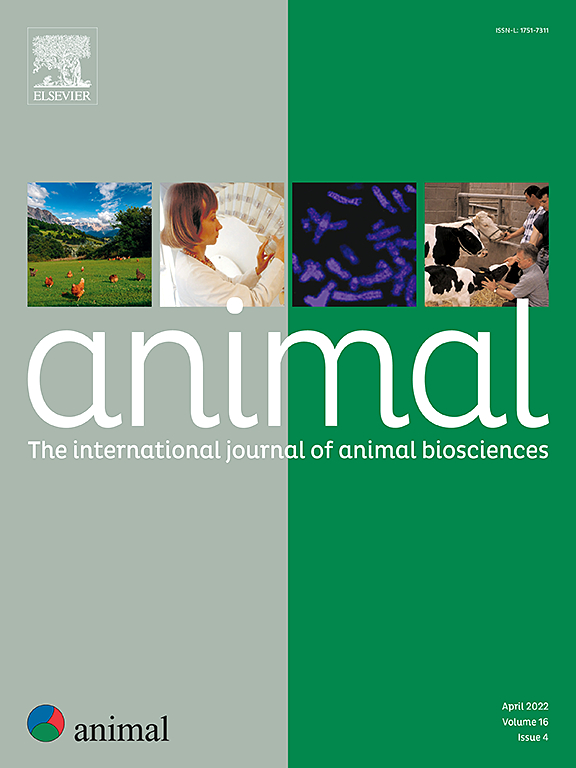Analysis of factors predisposing dairy Assaf ewes to marine lipid-induced milk fat depression
IF 4.2
2区 农林科学
Q1 AGRICULTURE, DAIRY & ANIMAL SCIENCE
引用次数: 0
Abstract
In sheep, diet-induced milk fat depression (MFD) results from ruminal alterations when ewes are fed marine lipids to modulate milk fatty acid profile and secretion. However, there is little available information on the relationship between characteristics existing before the consumption of MFD-inducing diets and response to those diets. Understanding predisposing factors for this condition may provide additional insight into the mechanisms of MFD and allow better predictions of its occurrence. Thus, a meta-analytical approach was used to identify traits that may predetermine the extent of marine lipid-induced MFD in individual Assaf sheep (a dairy breed with high genetic potential for milk production). Data were collected from 10 trials in which 160 ewes were fed 16 diets that included fish oil or marine algae until sustained MFD was observed. The decrease in milk fat concentration and yield was calculated using three approaches: absolute change (final – initial), relative change as a percent of pre-trial value, and potential change relative to the maximal expected MFD (assuming a maximal decrease to 3% milk fat). First, using bivariate analyses, there was a relationship between initial milk fat concentration and the absolute (R2 = 0.46; partial R2 of 0.08), relative (R2 = 0.39; partial R2 of 0.06), and potential changes in milk fat concentration during MFD (R2 = 0.17; partial R2 = 0.03). This finding was supported by a second approach that categorised ewes by initial milk fat concentration and yield and additionally by multivariate analyses. In addition, bivariate and multivariate analyses suggested that high MFD responsiveness in Assaf ewes was related to pre-trial milk yield and protein concentration, and to milk concentrations of candidate antilipogenic metabolites and the sum of preformed fatty acids. However, relationships were weaker than for initial milk fat concentration. Overall, when Assaf ewes were fed marine lipids, the higher the initial milk fat concentration, the greater the extent of MFD. The role of other performance traits and milk fatty acids as predisposing factors for marine lipid-induced MFD remains unclear.
奶牛阿Assaf母羊海洋脂质诱导乳脂抑制的易感因素分析
在绵羊中,饲粮诱导的乳脂抑制(MFD)是通过饲喂海洋脂来调节乳脂肪酸分布和分泌而引起的瘤胃变化。然而,关于食用诱发mfd的饮食之前存在的特征与对这些饮食的反应之间的关系,现有的信息很少。了解这种情况的易感因素可以为MFD的机制提供更多的见解,并可以更好地预测其发生。因此,采用荟萃分析方法来确定可能预先确定单个Assaf羊(具有高产奶遗传潜力的奶牛品种)海洋脂质诱导MFD程度的性状。从10个试验中收集了数据,其中160只母羊被喂食16种含有鱼油或海藻的日粮,直到观察到持续的MFD。乳脂浓度和产量的下降采用三种方法计算:绝对变化(最终-初始),相对变化(试验前值的百分比)和相对于最大预期MFD的潜在变化(假设最大减少至3%乳脂)。首先,使用双变量分析,发现初始乳脂浓度与绝对乳脂浓度之间存在相关性(R2 = 0.46;偏R2 = 0.08),相对R2 = 0.39;部分R2为0.06),以及MFD期间乳脂浓度的潜在变化(R2 = 0.17;偏R2 = 0.03)。这一发现得到了第二种方法的支持,该方法通过初始乳脂浓度和产量以及多变量分析对母羊进行了分类。此外,双变量和多变量分析表明,Assaf母羊的高MFD反应性与试验前产奶量和蛋白质浓度、候选抗脂代谢产物的乳浓度和预形成脂肪酸的总量有关。然而,与初始乳脂浓度相比,这种关系较弱。综上所述,饲喂海洋脂质时,初始乳脂浓度越高,MFD程度越大。其他性能性状和乳脂肪酸作为海洋脂质诱发MFD的易感因素的作用尚不清楚。
本文章由计算机程序翻译,如有差异,请以英文原文为准。
求助全文
约1分钟内获得全文
求助全文
来源期刊

Animal
农林科学-奶制品与动物科学
CiteScore
7.50
自引率
2.80%
发文量
246
审稿时长
3 months
期刊介绍:
Editorial board
animal attracts the best research in animal biology and animal systems from across the spectrum of the agricultural, biomedical, and environmental sciences. It is the central element in an exciting collaboration between the British Society of Animal Science (BSAS), Institut National de la Recherche Agronomique (INRA) and the European Federation of Animal Science (EAAP) and represents a merging of three scientific journals: Animal Science; Animal Research; Reproduction, Nutrition, Development. animal publishes original cutting-edge research, ''hot'' topics and horizon-scanning reviews on animal-related aspects of the life sciences at the molecular, cellular, organ, whole animal and production system levels. The main subject areas include: breeding and genetics; nutrition; physiology and functional biology of systems; behaviour, health and welfare; farming systems, environmental impact and climate change; product quality, human health and well-being. Animal models and papers dealing with the integration of research between these topics and their impact on the environment and people are particularly welcome.
 求助内容:
求助内容: 应助结果提醒方式:
应助结果提醒方式:


